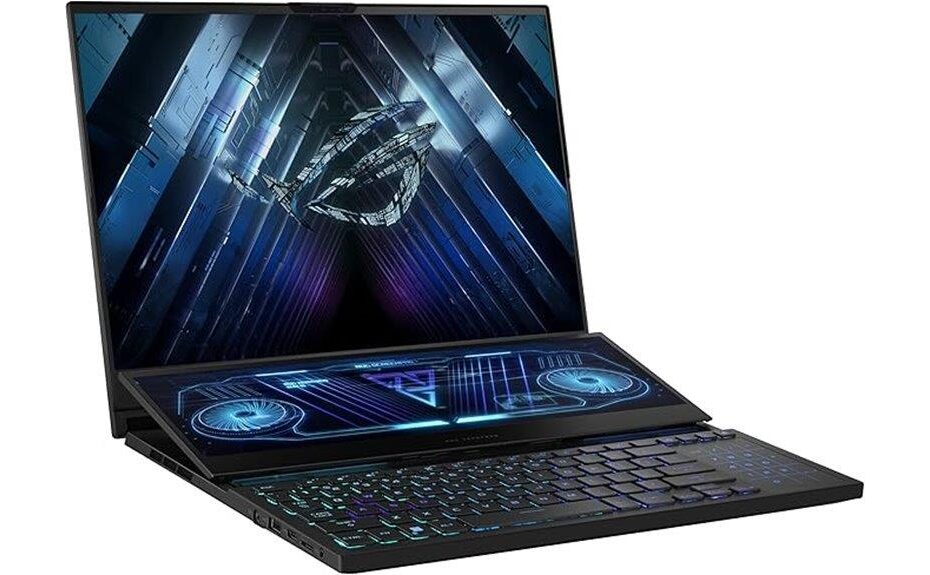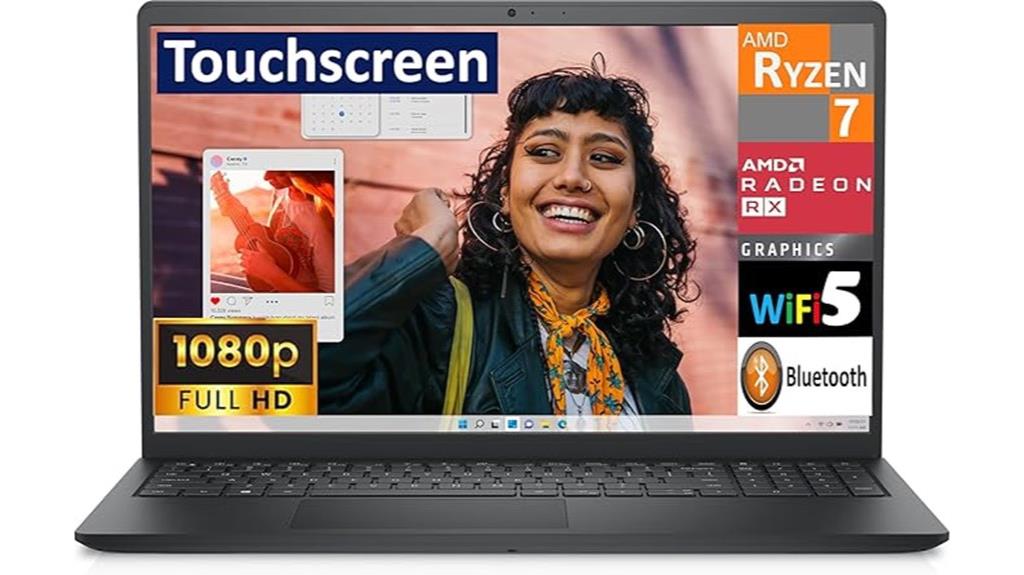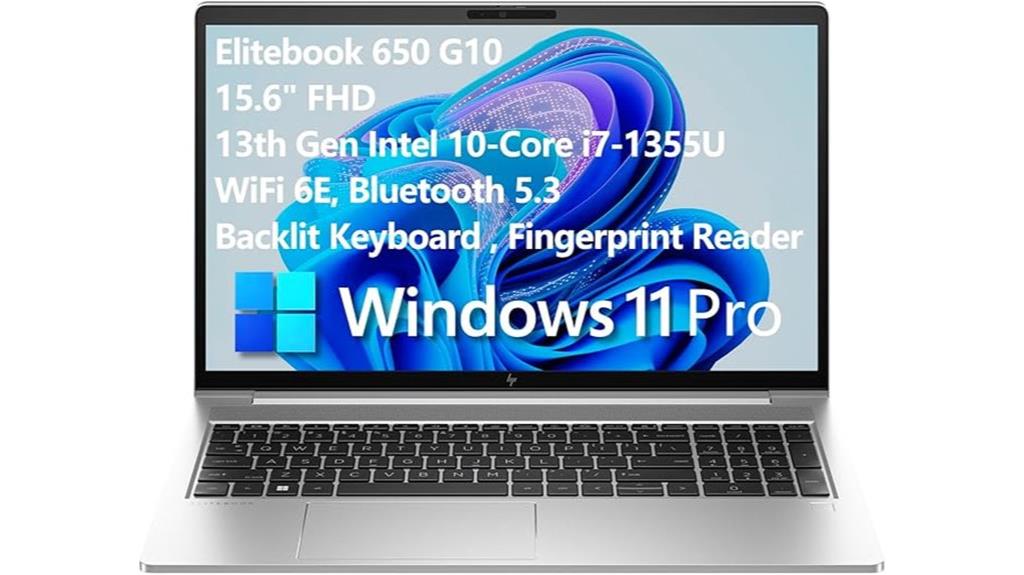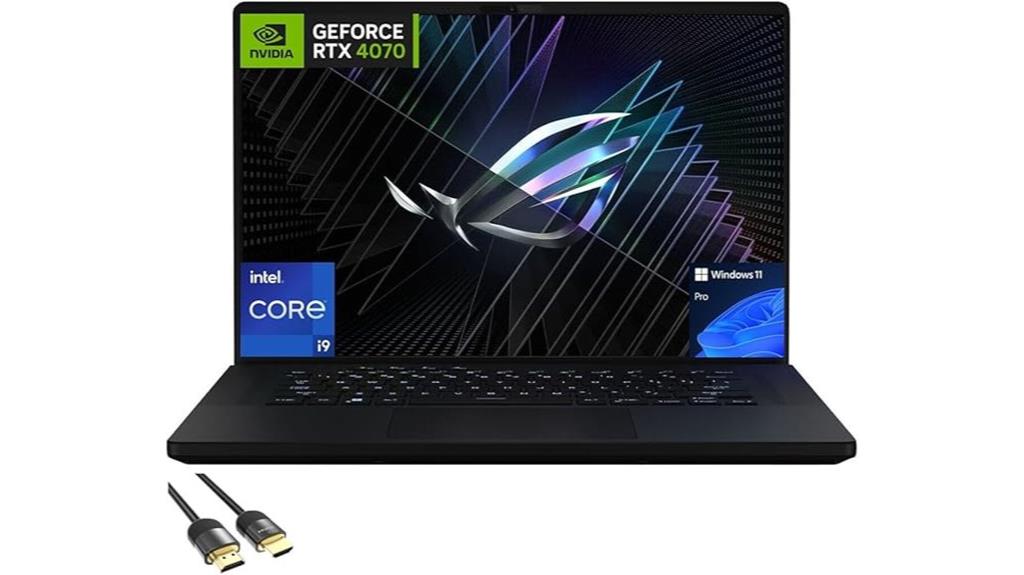

The ASUS ROG Zephyrus Duo 16 feels like a glimpse into the future of gaming laptops, but even the most advanced tech has its trade-offs. With its dual-screen design and top-tier specs, it's built to dominate, yet I can't ignore the compromises—thermal throttling and battery life that barely lasts an hour. Still, the liquid metal cooling and RTX 4090 performance are hard to dismiss. If you're chasing raw power and multitasking prowess, this machine might just redefine your expectations. But is it worth the price and the quirks? Let's explore what makes it stand out—and where it falls short.
Key Takeaways
- Dual-screen setup with 16" Mini LED QHD 240Hz main display and 14.1" secondary touchscreen for enhanced multitasking and productivity.
- Powered by AMD Ryzen 9 7945HX and NVIDIA RTX 4090 GPU, delivering top-tier gaming and creative performance.
- Liquid metal cooling system improves airflow but struggles with thermal throttling under heavy workloads, reaching up to 100°C.
- Premium build quality with customizable RGB lighting, but suffers from system instability, touchpad sensitivity, and short battery life.
- High-performance storage with 2TB PCIe 4×4 RAID 0 and 32GB DDR5 RAM, ideal for gaming and content creation.
##
The ASUS ROG Zephyrus Duo 16 delivers top-tier performance, thanks to its AMD Ryzen 9 7945HX processor and NVIDIA GeForce RTX 4090 Laptop GPU at 165W Max TGP. Its thermal management system, featuring upgraded liquid metal cooling and AAS Plus air intake, improves airflow by up to 30%, keeping temperatures in check during heavy workloads. However, CPU temps can still hit 100°C under stress, and liquid metal displacement issues may require reapplication. Battery optimization is a weak point, with the laptop lasting only 45 minutes during light tasks. While customizable fan speeds help manage heat, they increase noise levels. For better battery life, I recommend disabling the secondary screen and switching to eco mode, though this sacrifices some performance. Thermal and power efficiency remain areas for improvement. The liquid metal cooling system ensures peak performance during gaming, with optimized airflow design contributing to overall system stability and minimal thermal throttling during extended use.
Features and Benefits
The ASUS ROG Zephyrus Duo 16 excels with its dual-screen multitasking via the ROG ScreenPad Plus, offering enhanced productivity and airflow. Its Mini LED QHD 240Hz display delivers vibrant visuals with high brightness and color accuracy, though it struggles with color consistency at extreme settings. The liquid metal cooling system and customizable keyboard lighting further enhance performance and personalization, though thermal management and usability quirks remain notable trade-offs. The 144Hz display ensures smooth gameplay and reduces motion blur, making it ideal for competitive gaming environments.
Dual-Screen Multitasking With ROG Screenpad Plus
While the ROG ScreenPad Plus secondary display enhances multitasking capabilities, it's not without its limitations. The 14.1" touchscreen rises automatically, improving airflow and offering additional screen real estate for apps, tools, or reference material. However, screenpad ergonomics can be challenging; the angle isn't ideal for touch input, and glare can hinder visibility. Despite this, multitasking efficiency is substantially boosted, allowing me to run secondary tasks like Discord, OBS, or system monitoring without cluttering the main display. The integration with Windows 11 is seamless, but the touchpad's sensitivity can lead to accidental inputs. While the dual-screen setup excels in productivity, it's best suited for static tasks rather than dynamic touch interactions, making it a powerful yet niche feature for specific workflows.
Mini LED QHD 240Hz Display
Boasting a 16" Mini LED QHD 16:10 display with a 240Hz refresh rate and 3ms response time, the ASUS ROG Zephyrus Duo 16 delivers exceptional visual performance for gaming and productivity. The display calibration is factory-tuned, guaranteeing high color accuracy with 100% DCI-P3 coverage and Pantone validation, making it ideal for creative work. With 1024 dimming zones and 1100 nits peak brightness, it offers deep blacks and vibrant highlights, though colors can appear washed out at maximum brightness. The 240Hz refresh rate guarantees smooth motion clarity, while the 3ms response time minimizes ghosting. Despite its strengths, the display struggles with color consistency at lower brightness levels. Overall, it's a top-tier panel for both gaming and professional use, though calibration adjustments may be needed for peak performance.
Liquid Metal Cooling System
Although liquid metal cooling is a cutting-edge solution for thermal management, the ASUS ROG Zephyrus Duo 16 leverages this technology to enhance heat dissipation from its high-performance AMD Ryzen 9 7945HX processor. The system's cooling efficiency is markedly improved, allowing the laptop to handle intense workloads without throttling. However, I've observed issues with thermal displacement over time, as the liquid metal can shift, reducing its effectiveness. This necessitates periodic maintenance or replacement with alternatives like Honeywell 7950 thermal paste. Despite this drawback, the cooling system excels under heavy loads, keeping CPU temperatures manageable, though it can still peak at 100°C. Combined with the AAS Plus air intake, it guarantees sustained performance, albeit at the cost of increased fan noise. Overall, it's a powerful but high-maintenance solution.
Customizable Keyboard Lighting Options
The ASUS ROG Zephyrus Duo 16 offers customizable keyboard lighting through the Armoury Crate software, allowing users to tailor RGB effects to their preferences. This lighting customization enhances keyboard aesthetics while providing functional benefits like per-key illumination for better visibility in low-light environments. I can choose from static colors, dynamic effects, or sync lighting with in-game events for an immersive experience. However, I've noticed the settings reset to rainbow mode at startup, which can be frustrating. Despite this, the ability to personalize the keyboard's appearance adds a layer of individuality to the device. The lighting is bright and evenly distributed, ensuring a premium look. While the feature is impressive, its full potential is hindered by software inconsistencies that need addressing.
Product Quality
While the ASUS ROG Zephyrus Duo 16 delivers impressive hardware and innovative dual-screen functionality, its product quality is marred by significant thermal and stability issues. The build quality feels premium at first glance, but durability concerns arise with prolonged use. The liquid metal cooling, while effective initially, suffers from displacement issues, leading to overheating and requiring replacement with thermal paste. Frequent system instability, including sudden shutdowns and freezing, further undermines reliability. The touchpad's sensitivity and accidental inputs during typing add to usability frustrations. Despite its sleek design, the laptop's thermal management struggles under heavy loads, with CPU temperatures often hitting 100°C. These issues, combined with poor battery life, suggest that while the Zephyrus Duo 16 excels in performance, its overall product quality falls short of expectations. The 84-blade Arc Flow Fans found in the ASUS TUF Gaming A17 could have significantly improved the Zephyrus Duo 16's cooling efficiency, reducing overheating and enhancing stability.
What It's Used For
The ASUS ROG Zephyrus Duo 16 excels in high-performance gaming, leveraging its Ryzen 9 processor and RTX 4090 GPU for demanding titles. Its dual-screen setup enhances multitasking and productivity, allowing me to run multiple applications simultaneously without compromising performance. Additionally, the laptop's color-accurate displays and powerful hardware make it a strong contender for creative workstation applications like video editing and 3D rendering. The ScreenPad Plus feature provides a customizable second screen, significantly improving task management and workflow efficiency.
High-Performance Gaming
Designed to handle the most demanding gaming scenarios, the ASUS ROG Zephyrus Duo 16 excels in delivering top-tier performance for high-performance gaming. Powered by an AMD Ryzen 9 7945HX processor and an NVIDIA GeForce RTX 4090 Laptop GPU at 165W Max TGP, it's built for competitive gaming and esports performance. The 16" Mini LED QHD display with a 240Hz refresh rate guarantees smooth visuals, while the 32GB DDR5-4800MHz memory and 2TB PCIe 4×4 RAID 0 storage provide lightning-fast load times. Liquid metal cooling and AAS Plus air intake keep thermals in check, though temperatures can spike under heavy loads. Despite minor stability issues, it's a powerhouse for gamers seeking uncompromising performance in AAA titles and fast-paced esports environments.
Multitasking and Productivity
Although primarily marketed as a gaming laptop, the ASUS ROG Zephyrus Duo 16's dual-screen setup makes it a compelling choice for multitasking and productivity. The 14.1" ROG ScreenPad Plus secondary display elevates automatically, offering extra space for productivity enhancement tools like task managers, chat windows, or reference materials. I find screen management tips essential to maximize efficiency—dragging apps to the secondary screen frees up the main display for focused work. The Mini LED QHD main screen's high brightness and color accuracy are ideal for detailed tasks, though its color performance varies at different brightness levels. While the secondary touchscreen isn't perfect for touch input at certain angles, it's still a valuable asset for multitasking, especially when paired with the laptop's powerful Ryzen 9 processor and RTX 4090 GPU.
Creative Workstation Applications
With its dual-screen setup and high-performance hardware, the ASUS ROG Zephyrus Duo 16 excels as a creative workstation, particularly for tasks like video editing, 3D rendering, and graphic design. The 16" Mini LED QHD display with 100% DCI-P3 color accuracy guarantees precise color grading, while the secondary 14.1" ROG ScreenPad Plus provides extra workspace for timelines, tool palettes, or reference materials. The AMD Ryzen 9 7945HX and RTX 4090 GPU deliver exceptional rendering speeds, making it ideal for demanding creative workflows. However, the secondary screen's touch functionality can be awkward at certain angles, and the system's thermal performance under heavy loads may require manual fan adjustments. Despite these quirks, it's a powerhouse for professionals in video editing and graphic design.
Product Specifications
The ASUS ROG Zephyrus Duo 16 packs a powerhouse of hardware, featuring an AMD Ryzen 9 7945HX processor paired with an NVIDIA GeForce RTX 4090 Laptop GPU running at 165W Max TGP, ensuring top-tier gaming and productivity performance. With a processor speed of up to 5.4GHz and 32GB DDR5-4800MHz memory capacity, it handles demanding tasks effortlessly. The dual-screen setup includes a 16" Mini LED QHD display and a 14.1" ROG ScreenPad Plus, enhancing multitasking. Storage isn't lacking either, with 2TB PCIe 4×4 RAID 0 delivering up to 7000MB/s throughput. The dual-screen setup significantly boosts productivity by offering more screen real estate, allowing for efficient workflow organization.
| Component | Specification | Performance Impact |
|---|---|---|
| Processor | AMD Ryzen 9 7945HX | 5.4GHz, 16 cores |
| GPU | NVIDIA RTX 4090 (165W Max TGP) | High-end gaming, rendering |
| Memory | 32GB DDR5-4800MHz | Smooth multitasking |
| Storage | 2TB PCIe 4×4 RAID 0 | 7000MB/s throughput |
| Display | 16" Mini LED QHD, 240Hz | 1100nits, 100% DCI-P3 |
Who Needs This
If you're a power user or professional who demands uncompromising performance for gaming, content creation, or multitasking, the ASUS ROG Zephyrus Duo 16 is tailored for you. Its target audience includes professional gamers who need top-tier GPU performance, content creators requiring color-accurate displays, and tech enthusiasts seeking cutting-edge hardware. The dual-screen setup enhances productivity, making it ideal for multitasking workflows like video editing or streaming. However, its high-end specs and premium features come at a cost, both financially and with regard to portability. If you prioritize raw power and innovative design over battery life or thermal efficiency, this laptop fits your needs. For casual users or those on a budget, it's overkill, but for its intended audience, it delivers unmatched capabilities. The Nebula Display ensures vibrant colors and sharp contrast, enhancing visual immersion for gaming and creative tasks.
Pros
Although the ASUS ROG Zephyrus Duo 16 has its flaws, it excels in delivering top-tier performance and innovative features. Its dual-screen setup, with a 16" Mini LED QHD display and a 14.1" ROG ScreenPad Plus, enhances multitasking and productivity. The AMD Ryzen 9 7945HX and NVIDIA RTX 4090 GPU deliver desktop-level performance, making it a powerhouse for gaming and creative workloads. Thermal management is impressive, with liquid metal cooling and AAS Plus air intake improving airflow by up to 30%, though it can get noisy under heavy loads. Battery performance is limited, but the laptop runs cooler on battery, maintaining around 60°C during light tasks. The ROG Intelligent Cooling system ensures sustained performance during intense gaming sessions, similar to the ASUS ROG Strix G16.
- Dual-screen design for enhanced multitasking and airflow.
- Top-tier hardware with Ryzen 9 and RTX 4090 for unmatched performance.
- Advanced thermal management with liquid metal cooling and AAS Plus.
Cons
Despite its impressive hardware, the ASUS ROG Zephyrus Duo 16 struggles with significant thermal and stability issues. The laptop frequently hits thermal throttling limits, with CPU temperatures spiking to 100°C under load, even with liquid metal cooling. Battery longevity is another major drawback, lasting only 45 minutes during light tasks, making it impractical for on-the-go use. Additionally, the system suffers from instability, including sudden shutdowns and freezing during boot, which can disrupt productivity. The dual fans and exhaust system found in the Acer Nitro V could have mitigated some of these thermal challenges, offering better temperature regulation and sustained performance.
- Thermal throttling: CPU temperatures often exceed safe limits, reducing performance.
- Battery longevity: Poor battery life limits portability.
- System instability: Frequent crashes and freezes hinder usability.
These issues overshadow the laptop's high-end specs, making it a challenging choice for users prioritizing reliability and mobility.
What Customers Are Saying
While the ASUS ROG Zephyrus Duo 16 impresses with its dual-screen setup and top-tier hardware, customers have expressed mixed feelings about its real-world usability. Many report system instability, including frequent shutdowns and freezing during boot, which often require BIOS updates to resolve. Thermal issues are a recurring complaint, with the liquid metal cooling system sometimes failing to prevent overheating under heavy loads. The poor battery life, lasting less than an hour during light tasks, has also frustrated users. Additionally, the overly sensitive touchpad often leads to accidental inputs, disrupting workflow. Despite these drawbacks, the dual-screen functionality and raw performance receive praise, though the laptop's usability issues highlight a gap between its potential and practical experience. The 144Hz refresh rate on the secondary screen enhances fluidity, but it struggles to compensate for the overall thermal and battery inefficiencies.
Overall Value
The ASUS ROG Zephyrus Duo 16's overall value hinges on balancing its cutting-edge hardware and innovative dual-screen design against its practical shortcomings. In a price comparison, it's substantially more expensive than competitors like the Razer Blade 16 or Alienware x16, but its dual-screen functionality and top-tier specs justify the premium for power users. However, competitor analysis reveals alternatives with better thermal management and battery life, which are critical for sustained productivity. While the Zephyrus Duo 16 excels in raw performance and multitasking, its instability issues and poor battery life detract from its value proposition. For gamers and creators willing to overlook these flaws, it's a compelling choice, but casual users may find better value elsewhere. The laptop's innovative thermal design ensures effective heat dissipation during intense gaming sessions, maintaining optimal performance and user comfort.
Tips and Tricks For Best Results
To maximize the ASUS ROG Zephyrus Duo 16's potential, I recommend starting with a BIOS update to address system instability and avoid frequent crashes. For battery optimization, switch to eco or optimized mode and disable the secondary screen when not in use. This greatly extends runtime during light tasks. For thermal management, consider replacing the liquid metal cooling with Honeywell 7950 thermal paste to prevent displacement issues. Customize fan speeds in the Armoury Crate app to balance noise and temperature control. Avoid running heavy workloads on battery to prevent overheating. Regularly monitor CPU temps and adjust performance profiles accordingly. These tweaks guarantee smoother operation and better longevity for this high-performance machine.
Conclusion
After implementing the recommended tweaks and optimizations, it's clear the ASUS ROG Zephyrus Duo 16 is a powerhouse with impressive dual-screen functionality and top-tier performance. However, thermal management remains a challenge, with CPU temperatures hitting 100°C under load, despite liquid metal cooling and AAS Plus airflow. Battery optimization is another weak point, lasting only 45 minutes during light tasks, making it impractical for on-the-go use without a charger. While the dual-screen setup excels for multitasking, stability issues like sudden shutdowns and BIOS-related bugs detract from the experience. For users prioritizing raw power and innovative design, the Zephyrus Duo 16 delivers, but its thermal and battery limitations require careful consideration. It's a high-performance machine with room for refinement.



